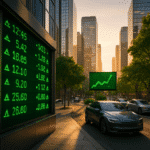Key Takeaways
- US corporate share buyback announcements reached a record $166 billion in July 2024, nearly doubling the previous high for the month set in 2006.
- The surge is primarily driven by strong corporate balance sheets in the finance and technology sectors, with firms opting to return cash to shareholders rather than pursue large capital expenditures.
- These repurchases mechanically boost earnings per share (EPS) and are projected to contribute significantly to S&P 500 EPS growth in 2024, providing a potential floor for stock prices.
- While viewed as a bullish signal of boardroom confidence, the unprecedented scale of buybacks also raises concerns about depleting cash reserves, potential over-leveraging, and prioritising short-term stock performance over long-term investment.
Corporate America’s voracious appetite for repurchasing its own shares reached unprecedented heights in July 2024, with announcements totalling $166 billion—a figure that shattered previous records for the month and signalled a profound shift in capital allocation strategies amid fluctuating market conditions.
The Surge in Buyback Announcements
July’s buyback bonanza, nearly double the prior high set in 2006, underscores a broader trend where US firms are funnelling excess cash back to shareholders at a pace that outstrips even the most optimistic projections. This escalation arrives against a backdrop of economic uncertainty, yet it reflects a calculated optimism from boardrooms, betting on sustained earnings growth to justify such aggressive moves. Data from Birinyi Associates highlights how this monthly tally propelled year-to-date announcements to $926 billion, eclipsing the 2022 record by $108 billion with months still to spare.
Such volumes do not emerge in isolation; they stem from a confluence of robust corporate balance sheets and a permissive interest rate environment that has lingered longer than anticipated. Companies, flush with profits from prior quarters, are opting to reduce share counts rather than hoard liquidity or invest in expansive projects. This approach, while shareholder-friendly in the short term, invites scrutiny on whether it prioritises immediate stock price support over long-term innovation.
Implications for Earnings and Valuations
At its core, this buyback frenzy acts as a mechanical booster for earnings per share (EPS), a metric that often dictates executive compensation and investor sentiment. By shrinking the denominator—the outstanding shares—firms can amplify reported profits without necessarily growing the underlying business. Analyst models from Goldman Sachs, projecting total 2024 buybacks to hit $1.15 trillion, suggest this could contribute up to 16% of EPS growth for S&P 500 constituents, a figure that aligns with historical patterns where repurchases have masked sluggish revenue expansions.
Yet, the implications extend beyond arithmetic. In a market where valuations hover near multi-year highs, these repurchases provide a floor under stock prices, potentially mitigating downside risks during volatile periods. Analysis from earlier in 2024 anticipated this revival, noting that buybacks could serve as a stabilising force amid geopolitical tensions and inflation concerns. For investors, this translates to a subtle endorsement from management: a belief that shares are undervalued or, at the very least, that repurchasing them yields better returns than alternative deployments of capital.
Sectoral Drivers and Key Players
Financial and technology sectors dominate this wave, accounting for a lion’s share of the $166 billion announced in July. Heavyweights from the banking sector have made substantial commitments, underscoring a broad sectoral confidence following regulatory stress tests.
| Company | Announced Buyback Programme |
|---|---|
| JPMorgan Chase | $50 billion |
| Bank of America | $40 billion |
| Morgan Stanley | $20 billion |
Technology firms, not to be outdone, continue a tradition of aggressive repurchases, building on Q2 2024’s $236 billion surge that approached all-time records. According to S&P Global data, the top 20 S&P 500 firms executed 52% of Q2 buybacks, a deviation from the long-term average of 48%, indicating that mega-caps are increasingly the engines of this trend. The implication here is clear: in an era of concentrated market power, buybacks amplify the influence of these giants, potentially widening the gap between market leaders and laggards.
Market Sentiment and Broader Economic Signals
Sentiment among verified financial analysts, as echoed in reports from Janus Henderson Investors, views this as a bullish indicator, with global buybacks nearing parity with dividends—a stark evolution from a decade ago when repurchases were half as prevalent. This shift implies a preference for flexible capital returns, allowing companies to adjust amid economic headwinds without committing to perpetual payouts. Commentary on Yahoo Finance labels Corporate America’s “obsession” with buybacks as a barometer of confidence, suggesting that executives perceive limited recession risks despite mixed macroeconomic data.
However, not all interpretations are rosy. Critics argue that such scale could foreshadow over-leveraging, reminiscent of pre-2008 excesses when buybacks masked underlying fragilities. Earlier forecasts warned of constraints for highly rated firms, where further balance sheet releveraging becomes untenable. The dark wit in this scenario? Companies might be buying high only to sell low in a downturn, a cycle that has burned investors before.
Investor Considerations and Forward Outlook
For portfolio managers, this record July haul prompts a re-evaluation of allocation strategies. Buybacks can enhance total shareholder yield, combining dividends and repurchases into a more comprehensive return metric. Projections estimate US firms repurchasing $1 trillion by year-end 2025, positioning them as the market’s largest net buyers of equities—a role traditionally held by institutions but increasingly ceded to corporates themselves.
Looking ahead, analyst-led forecasts from Birinyi Associates anticipate a moderation in Q3, potentially influenced by election-year uncertainties or shifting monetary policies. Yet, if July’s momentum persists, it could underpin a resilient equity market, countering bearish narratives with tangible capital flows. The key implication remains: in buying back shares at this clip, Corporate America is not just signalling confidence—it is actively engineering it.
Analysis of 2024 trends from Empower notes that buybacks constituted three-fifths of the $1.6 trillion returned to investors last year, a proportion likely to hold or expand given July’s outlier performance. Investors would do well to monitor execution rates, as announcements often outpace actual repurchases, but the sheer volume here suggests a commitment that could redefine market dynamics.
Potential Risks in the Buyback Boom
Amid the enthusiasm, risks loom. Excessive repurchases can deplete cash reserves, leaving firms vulnerable to shocks—a lesson from the pandemic era when many suspended programmes mid-crisis. Moreover, in a high-interest environment, debt-financed buybacks could strain credit profiles, especially for the 50% of S&P 500 companies rated BBB, as per historical Goldman Sachs insights. The implication? What begins as a vote of confidence might evolve into a liability if economic winds shift.
Darkly amusing, perhaps, is the irony that these record announcements coincide with calls for corporate reinvestment in workers and infrastructure, yet the data shows capital flowing predominantly to equity holders. As an S&P Global report indicated a 20.6% quarterly increase to $293 billion in Q1 2025, with expectations of a Q2 decline, the July spike defies that trajectory, hinting at opportunistic timing amid summer market dips.
In essence, July 2024’s $166 billion milestone encapsulates a pivotal moment for US equities, where buybacks are not merely a tactic but a statement of intent. Whether this fuels sustained rallies or sows seeds of imbalance will depend on execution and external factors, but for now, it reaffirms corporates as pivotal market actors.
References
Bloomberg. (2024, May 31). Buybacks Reach $201 Billion, a Record for May, Birinyi Data Show. Bloomberg. https://www.bloomberg.com/news/articles/2024-05-31/buybacks-reach-201-billion-a-record-for-may-birinyi-data-show
Bloomberg. (2025, May 6). Corporate America Plans Record Stock Buybacks as Turmoil Mounts. Bloomberg. https://www.bloomberg.com/news/articles/2025-05-06/corporate-america-plans-record-stock-buybacks-as-turmoil-mounts
Bloomberg. (2025, August 5). Buybacks Reach $166 Billion for Biggest July Ever, Birinyi Says. Bloomberg. https://bloomberg.com/news/articles/2025-08-05/buybacks-reach-166-billion-for-biggest-july-ever-birinyi-says
IndexBox. (2024, July 31). US Companies to Repurchase $1 Trillion in Stocks by 2025. IndexBox. https://www.indexbox.io/blog/us-companies-to-repurchase-1-trillion-in-stocks-by-2025/
Janus Henderson Investors. (2024, May 29). Global share buybacks surge to a record $1.31 trillion almost equalling dividends [Press release]. https://www.janushenderson.com/en-us/advisor/press-releases/global-share-buybacks-surge-to-a-record-1-31-trillion-almost-equalling-dividends/
Kobeissi Letter [@KobeissiLetter]. (2024, April 24). S&P 500 companies are on track for a record $1.7 TRILLION of stock buybacks and dividends in 2024… [Post]. X. https://x.com/KobeissiLetter/status/1782941569567330684
Kobeissi Letter [@KobeissiLetter]. (2024, October 26). BREAKING: S&P 500 companies have now announced a record $1.26 TRILLION in stock buybacks this year… [Post]. X. https://x.com/KobeissiLetter/status/1861440414013628482
Legum, J. [@JuddLegum]. (2018, July 29). Here is a list of corporations announcing stock buybacks… [Post]. X. https://x.com/JuddLegum/status/1023926173926080513
Reuters. (2024, February 2). Projected buyback revival stands to bolster US stocks in 2024. Reuters. https://www.reuters.com/markets/us/projected-buyback-revival-stands-bolster-us-stocks-2024-2024-02-02/
Rischall, S. (2024, July 31). Stock buybacks: A guide for investors. Empower. https://www.empower.com/the-currency/money/stock-buybacks-news
S&P Global. (2025, June 25). S&P 500 Q1 2025 Buybacks Set Quarterly Record at $293 Billion, Up 20.6% [Press release]. https://press.spglobal.com/2025-06-25-S-P-500-Q1-2025-Buybacks-Set-Quarterly-Record-at-293-Billion,-Up-20-6-,-Helping-EPS-Growth-Impact-and-Expenditures-Expected-to-Decline-in-Q2-2025
Schafer, J. (2024, May 3). Corporate America remains obsessed with stock buybacks. Yahoo Finance. https://finance.yahoo.com/news/corporate-america-remains-obsessed-with-stock-buybacks-130608383.html
Yahoo Finance. (2024, February 26). US corporate stock buybacks pace to jump 10% this year: BofA [Video]. Yahoo Finance. https://finance.yahoo.com/video/us-corporate-stock-buybacks-pace-173000947.html
Zschaepitz, H. [@Schuldensuehner]. (2019, March 16). Good Morning from #Germany where the buyback boom in the US may be coming to an end… [Post]. X. https://x.com/Schuldensuehner/status/1106502046247579648














